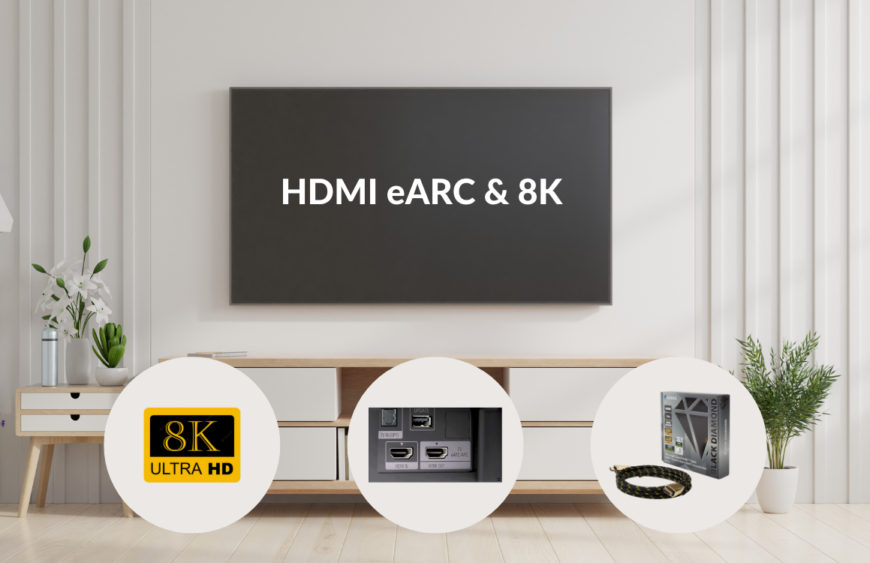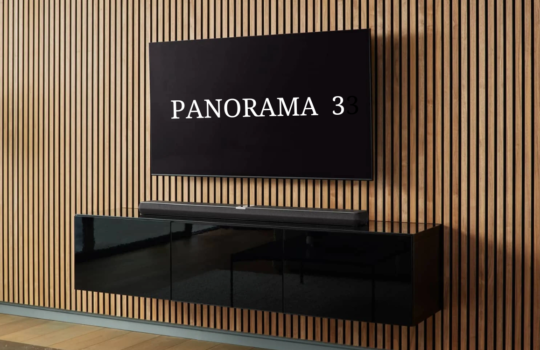The trusty HDMI or ‘High-Definition Multimedia Interface’ has been the go-to digital connector for TVs, projectors and other AV equipment for over 15 years now. During that time it’s evolved into the ultimate all-in-one connection, acting as a conduit for various video and audio formats, which, unfortunately, requires even more acronyms.
HDMI ARC (that’s Audio Return Channel) is a clever protocol that sits within the HDMI standard and, in theory, it can help simplify a complicated AV set-up and reduce the number of cables you need.
But what’s the point of it? And where does the more recent eARC fit in this picture? Read on for all the info you need (and more).

What’s HDMI and HDMI ARC?
HDMI launched way back in 2002, and the first consumer kit to feature this high-tech connector hit the shops in 2004.
It was billed as a convenient way to send high-quality digital picture and sound data ‘upstream’ from a source to a TV, amplifier or soundbar. As HDMI has become the de facto AV connection, traditional analogue sockets such as SCART and component video have found themselves consigned to the spare parts bin. The HDMI interface has evolved over the years, with new versions (HDMI 2.1 is the latest) bringing support for new audio and video technologies such as 3D, 4K, 8K, HDR and high frame rates, to name but a few.
It wasn’t until 2009 that the HDMI ARC protocol was added to the spec-sheet. It was introduced as part of HDMI version 1.4 and has been part of the specification ever since.
Previously, you would have to connect an optical cable from the back of your TV to an optical input on your audio device.
But that’s a messy solution. Theoretically, HDMI ARC solves this problem.
HDMI ARC removes the need for an optical cable and allows you to send audio ‘downstream’ from a compatible HDMI socket on your TV to a compatible HDMI ARC socket on a soundbar or AV receiver.
What do you need to use HDMI ARC?

To take advantage of HDMI ARC, you’ll need a television and audio processor (AV receiver or soundbar) with matching ARC-enabled HDMI sockets.
Peer around the back of your TV – if it’s packing three or four HDMI sockets, you need to find the one that’s labelled “(ARC)”. Labelling isn’t compulsory, but as long as your TV is a late-2009 model or newer, there should be one at your disposal. Consult the TV’s user manual if you’re unsure.
With some TVs, HDMI ARC might work automatically. If it doesn’t, you’ll need to grab a remote and tweak a few of your TV settings, including turning off your TV’s built-in speakers and enabling your telly to send audio out to an external speaker or amp.
Using HDMI ARC does not require a new HDMI cable. Any HDMI cable should be able to cope with the requirements – it’s only when we move on to eARC this could (potentially) become an issue. But more on that later.
As part of the process, you should consider enabling HDMI CEC (Consumer Electronics Control), so you can turn your TV on and control the volume on your soundbar or amp without the need for multiple remotes. A word of warning, though: turning HDMI CEC on can have some unwanted AV side-effects – so you might want to experiment first.
Are there any issues with HDMI ARC?

The biggest problem for ARC in its current guise is manufacturers have been left to pick and choose which elements of the protocol they want to include.
Support for all relevant audio codecs isn’t compulsory, so you can’t simply assume that a TV will be able to send a 5.1 Dolby Digital or DTS soundtrack from a movie over ARC. Some TV manufacturers only support Dolby Digital, while others only support two-channel stereo, defeating the point.
It’s worth noting ARC doesn’t allow you to bitstream the full-fat high-quality codecs such as Dolby TrueHD, Dolby Atmos, DTS-HD Master Audio or DTS:X soundtracks that you find on Blu-rays and 4K Blu-rays. It simply strips out the core 5.1 data stream. If you want this level of functionality, you’ll need HDMI eARC.
ARC can, however, allow you to receive Dolby Atmos audio from streaming services such as Netflix, Disney Plus and Amazon Prime Video, as these services embed Dolby Atmos in the lossy Dolby Digital Plus format which ARC can handle.
What is HDMI eARC? What are the benefits?

Enhanced Audio Return Channel (also known as eARC) is the next generation of ARC. It’s a feature implemented in the most recent HDMI 2.1 specification.
The main benefit of eARC is a big boost in bandwidth and speed. This allows you to send higher-quality audio from your TV to a soundbar or AV receiver.
There’s scope for eARC to deliver up to 32 channels of audio, including eight-channel, 24bit/192kHz uncompressed data streams at speeds of up to 38Mbps.
This means all those high bitrate formats currently available on Blu-ray discs, 4K Blu-rays and some streaming services – Dolby TrueHD, DTS-HD Master Audio and object-based formats such as Dolby Atmos and DTS:X – will all be compatible.
But whether manufacturers choose to support them all is up to them.
On paper, HDMI eARC also makes the handshake between compatible devices much smoother and negate the need to activate HDMI CEC (which doesn’t always work properly) – so operating multiple products shouldn’t require any extra steps to get things up and running.
As is the case with ARC, you’ll need two devices with compatible HDMI eARC sockets for the protocol to work. While a device doesn’t specifically have to be HDMI 2.1-certified, HDMI 2.1 certification does just about guarantee eARC support.
LG was the first manufacturer to go all-in with the new standard producing the first 4K TVs to sport HDMI 2.1 ports in 2019. All LG’s 2022 OLED TVs have up to four HDMI 2.1 ports, with Samsung offering one on most models and four on its flagship sets. Meanwhile, much of Pansonic and Sony’s 2022 ranges, also sport a mixture of ports.
Plenty of products other than tVs also offer eARC connectivity. Onkyo and Pioneer were the first to offer eARC updates on select AV products such as the Onkyo TX-RZ830, Integra DRX-5.2, Pioneer SC-LX502 and Pioneer VSX-LX503 AV receivers.
In 2018 Denon launched its first eARC-compatible AV receivers and then in 2020 also started future-proofing its AV receivers with models such as the AVC-X3700H offering full HDMI 2.1 on one of its seven inputs and two of its three outputs, while the AVC-X6700H’s eight inputs and two of its three outputs are HDMI 2.1 certified.
Sony followed quickly with updates to its soundbars (HT-ST5000, HT-ZF9, HT-XF9000) and AV receivers (STR-DH790, STR-DN1080), making them compatible with eARC-supported Sony AF9 and ZF9 TV models.
Recent soundbars such as LG’s 2022 Dolby Atmos SQ range, the award-winning Sonos Arc and Samsung’s QA range will include eARC-compatible HDMI 2.1 outputs.
Do I need new HDMI cables to use eARC?
According to HDMI.org, if you currently use a standard HDMI cable with Ethernet, or a High-Speed HDMI cable with Ethernet, you should be fine. Ultra High-Speed HDMI cables with Ethernet will definitely work.
Because of the extra bandwidth needed for some audio formats over eARC, it’s possible that very old cables could struggle. In January 2020 HDMI.org announced a mandatory certification programme to ensure that any cable labelled Ultra High Speed supports all HDMI 2.1 features including eARC.
Is eARC backwards compatible with ARC?
If your TV is HDMI eARC enabled, but your AV amp or soundbar is only compatible with HDMI ARC, you’ll likely get a sound – but the bandwidth restrictions of ARC will mean you won’t be able to experience the high bitrate audio that eARC can provide. So no, it’s not backwards-compatible.
Some AV receivers and soundbars that don’t have HDMI 2.1 chipsets can be upgraded to support eARC, but it varies between manufacturers and products. It depends if they are using compatible hardware that can accept the necessary firmware update.
Time will tell how well-integrated eARC will be, but it seems likely to become just as ubiquitous as HDMI ARC has been.

What’s HDMI 2.1 and 8K Support?
The HDMI 2.1a Specification includes a new cable – the Ultra High Speed HDMI® Cable. It’s the only cable that complies with stringent specifications designed to ensure support for all HDMI 2.1a features including uncompressed 8k@60 and 4K@120. The cable’s increased bandwidth capability supports up to 48Gbps.
The Ultra High Speed HDMI Certification Program is a mandatory certification program for all Ultra High Speed HDMI Cables; and ensures quality Ultra High Speed HDMI Cables reach the market and support 4K and 8K video, HDR, VRR, eARC, and all other HDMI 2.1a features. Cables are also required to be tested and certified to ensure low EMI to reduce the possibility of interference with wireless networks, streaming media players, Bluetooth devices and mobile phones.
All certified cables of any length must pass certification testing at an HDMI Forum Authorized Testing Center (Forum ATC). Once certified, cables will be required to affix an Ultra High Speed HDMI Certification Label to each package or unit of sale enabling consumers to verify the certification status of the product.

To identify the cable, make sure the packaging displays the required Ultra High Speed HDMI Certification Label shown above. Please note the label includes the official Cable Name Logo printed on it. The name is also required to appear on the outer cable jacket itself. To verify the cable has been tested and certified in compliance with the HDMI 2.1a Specification, the label can be scanned by the HDMI Cable Certification app available on the Apple App Store, Google Play Store and other Android app stores. We recommend KONIG HDMI Cables for best performance with your system.







